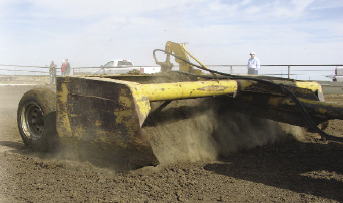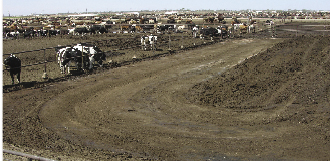
Features
Applications
Beef
Cleaner manure burns hotter in ethanol processing
March 9, 2008 by Kay Ledbetter
Clean manure may sound like an
oxymoron, but Dr. Brent Auvermann is working with Texas feedyard owners
to help them get the most ‘spark’ from it as a fuel source.
Clean manure may sound like an oxymoron, but Dr. Brent Auvermann is working with Texas feedyard owners to help them get the most ‘spark’ from it as a fuel source.
 |
| Dr. Brent Auvermann, a Texas Co-operative Extension engineering specialist, advises feedyard operators to pay close attention to blade depth when harvesting manure from corral surfaces as a boiler fuel source.
Photos By Sharon Preece, Texas Co-Operative Extension.
|
Dr. Brent Auvermann, a Texas Co-operative Extension engineering specialist, recently hosted a seminar entitled Producing High-Value Manure for BioFuels and Fertilizer in Hereford, Texas. The meeting outlined work by Texas Agricultural Experiment Station researchers to determine best management practices for scraping manure from the feed pens.
“We’re doing something that has never been done before,” says Arles ‘Bugs’ Graham, Panda Energy International’s general manager for the Hereford plant. Graham spoke at the meeting. “We’re using your manure as an energy source,” he says. “It’s a very complex process.”
After starting up the plant with natural gas as the boiler fuel, Panda Energy will eventually use manure as a fuel source when producing ethanol for an E10 fuel blend, Graham explains.
The plant will initially process corn for ethanol, although the company is looking at alternative sources of starch to make the ethanol. It will produce distiller’s grains as a by-product. “But manure is our future,” Graham says, estimating each plant will use 1500 tons a day.
Jim Adams, Panda Energy vice-president of fuels, says the plant will begin asking yards, in June, to sign up for a percentage of their manure. The past winter was a wake-up call, Adams says. Sometimes, when the weather is too wet, manure cannot be harvested from the pens. Manure will be used by this fall, so “we have to start stockpiling now” to ensure a steady supply.
Adams says the plant will use manure on a six day basis, requiring
70 to 80 truckloads per day. Panda’s contractor will collect from the pens when they are dry enough, but will need to pull from stockpiles when pen surfaces are too wet.
Quality is the biggest issue, Dr. Auvermann says. The manure needs to burn at a minimum rate of 2758 British Thermal Units (BTU) per pound of manure. That number changes according to the amount of pollutants – moisture and dirt – included when the pen is scraped. If all the water and contaminants were removed from the manure, the highest quality would be 8500BTU, “but we can’t do that, because we can’t take the ash out completely,” he says.

|
| Cleaning manure from feed pens is a common practice, but one that will have to be done more carefully in the future if the harvested product is to be used as a fuel source, according to Dr. Brent Auvermann, a Texas Co-operative Extension specialist. |
Manure from soil-surfaced pens may not always meet the minimum heating value on an ‘as received’ basis, Dr. Auvermann notes. Feedyard operators will have to take some steps to improve it. The timeliness of collection and depth of scraping will be key to keeping dirt content below 60 percent and moisture content below 20 percent, he explains.
“Paving the pens with a crushed ash or a fly-ash material (from coal-fired power plants) will end up returning to you in the form of heating value – big time,” says Dr. Auvermann. Partially composted manure from paved pens can have a heating value almost equivalent to that generated by burning Texas lignite coal.
Feedyard owners should consider the process as ‘harvesting manure’ rather than cleaning pens, Dr. Auvermann says. The ultimate goal is to have a hard, smooth, well-drained corral surface. Implementing good practices will pay at the bottom line. Conscientious manure harvesting can result in higher fuel and fertilizer values, reduced feed requirements for cattle, improved pen drainage, and reduced odor, dust and flies.
Kay Ledbetter is a writer with Texas A&M University’s News and Public Affairs Department.